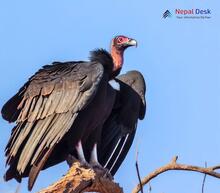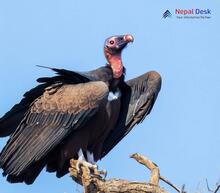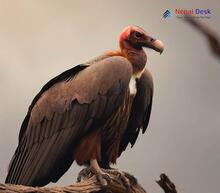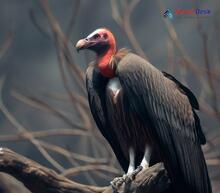The Sarcogyps genus, a unique group of birds belonging to the vulture family, has long captivated the interest of biologists and bird enthusiasts alike. With their striking appearance and intriguing behaviors, these magnificent creatures have a fascinating evolutionary history. In this article, we'll explore the origin, evolution chain, taxonomy, morphology, ecology, and presence of the Sarcogyps genus in Nepal.
Origin & Evolution Chain
The Sarcogyps genus is part of the Accipitridae family and comprises only one species: the Red-headed Vulture (Sarcogyps calvus). This species traces its roots back millions of years and is believed to have evolved from a shared ancestor with eagles and other birds of prey. Over time, Sarcogyps calvus adapted to its environment and developed specialized features that enabled it to thrive as a scavenger.
Taxonomy
Within the Accipitridae family, the Sarcogyps genus belongs to the Aegypiinae subfamily which consists of Old World vultures. These vultures are further classified into two distinct groups – Gyps and Aegypius. The Red-headed Vulture is unique among these groups because it doesn't belong to either one; as such it's classified under its own separate monotypic genus – Sarcogyps.
Morphology
A distinguishing feature of the Red-headed Vulture is its striking red head contrasted against its black plumage. Adults possess a noticeable bald head devoid of feathers – an adaptation thought to aid in thermoregulation and hygiene when feeding on carcasses. They have a powerful beak which allows them to tear through flesh easily and feed on carrion efficiently. Their wingspan ranges from 6 to 8 feet, enabling them to glide effortlessly for long periods in search of food.
Ecology
Found mainly in the Indian subcontinent and southeastern Asia, Red-headed Vultures prefer open grasslands, savannas, and forests near human settlements. As carrion feeders, they play a crucial role in their ecosystem by consuming dead animals and preventing the spread of diseases. The vultures live a solitary life, even during the breeding season, which differentiates them from other species that form large nesting colonies.
Presence in Nepal
Nepal is among the countries where the Red-headed Vulture maintains a presence. Unfortunately, their numbers have significantly declined over the past few decades due to habitat loss, poisoning from veterinary drugs (such as diclofenac) used on livestock, and scarcity of food sources. Conservation organizations are now working to improve protection measures and raise awareness about these captivating birds to help safeguard their future in Nepal.
In conclusion, the Sarcogyps genus is a remarkable example of evolution and adaptation. With their striking appearance and crucial ecological role as scavengers, Red-headed Vultures play a vital part in our world's biodiversity. By understanding their origin, taxonomy, morphology, ecology, and presence in regions like Nepal, we can better appreciate these awe-inspiring birds and emphasize the importance of their conservation efforts.




